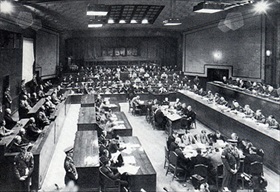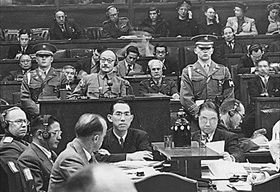JAPANESE WAR CRIMINALS SENTENCED
Tokyo, Japan • November 12, 1948
On this date in 1948 some 28 verdicts for Class A war criminals were read out at the International Military Tribunal for the Far East (IMTFE), better known as the Tokyo Trials or the Tokyo War Crimes Tribunal. Convened in the Japanese capital, Tokyo, on April 29, 1946, to try Japan’s highest-ranking political and military leaders, the defendants were charged with committing crimes against peace and conspiring jointly to start and wage aggressive war. (Both charges were required for prosecuting Class A war criminals.) “Class B” war crimes were typically reserved for lower-ranking individuals who allegedly committed “conventional” atrocities such as murder, massacres, extermination, human experimentation, torture, rape, and pillaging helpless civilians; these individuals were tried by Allied War Crimes Courts inside Japan and outside, in countries that made up the victorious Allies such as China, the Philippines, Australia, Great Britain, the United States, and the Soviet Union. “Class C” war crimes, namely, crimes against humanity, were reserved for those engaged in planning, ordering, authorizing, or failing to prevent such transgressions at higher levels in the command structure. In all, more than 5,700 individuals were charged with committing Class B and C war crimes, of which over 1,300 were either acquitted, never brought to trial, or not sentenced.
Modeled on the Nuremberg Trials in postwar Germany (November 1945 to October 1946), Gen. Douglas MacArthur, the Supreme Commander of the Allied Powers, set in motion the Tokyo Trials in January 1946. He appointed a tribunal of 12 judges, 9 of whom were representatives of nations that had signed the Japanese Instrument of Surrender on September 2, 1945. The chief prosecutor, appointed by President Harry S. Truman, was assisted by 10 other prosecutors. The defendants were represented by 79 Japanese and 25 American attorneys, plus a support staff. Of the original 30 in the dock, 9 were civilian officials (mostly prime ministers and foreign ministers), 1 was a political philosopher, and the rest were members of the Japanese armed services. Shōwa Emperor Hirohito and all members of the Japanese imperial family, such as Prince Yasuhiko Asaka who was implicated in the Nanking (Nanjing) Massacre in 1937, were not prosecuted for involvement in any of the 3 categories of crimes. As the historian Herbert Bix explained (see text box below), “the Truman administration and Gen. MacArthur both believed the occupation reforms would be implemented smoothly if they used Hirohito to legitimize their changes.” MacArthur went so far as to tell the emperor (via intermediaries) that he “should never abdicate,” a topic that engaged the Japanese public during the trials. Hirohito wrote back to say that he was committed to staying on the throne in order to work for the reconstruction of his country.
Perhaps the most notorious defendant at the Tokyo Trials was Gen. Hideki Tōjō, Chief of Staff of the Kwantung Army in Japanese-occupied China (1937–1938), Japanese war minister (1940–1944), prime minister (1941–1944), chief of the Imperial Japanese Army General Staff Office (1944). Tōjō was sentenced to death and hanged, along with 4 other former Japanese generals, at Sugamo Prison outside Tokyo on December 23, 1948. Tōjō’s sentence, like those of the other defendants, was confirmed by MacArthur. Sixteen defendants were sentenced to life imprisonment. Three died in prison, while the other 13 were paroled between 1954 and 1956 after MacArthur had left Japan.
![]()
International Military Tribunal for the Far East, April 1946 to November 1948
 |  |
Left: Held in the former Imperial Japanese Army headquarters building in Tokyo, the International Military Tribunal for the Far East was convened on April 29, 1946, and adjourned 2½ years later on November 12, 1948, after having spent 6 months reaching judgment and drafting its 1,781‑page opinion. In this photograph, the judges bench appears on the right, the defendants’ dock is on the left, and the prosecutors are seated in the rear.
![]()
Right: Former Japanese Prime Minister Hideki Tōjō (in glasses with headphone) was tried by the International Military Tribunal for the Far East for war crimes and found guilty of waging wars of aggression (5 counts), waging unprovoked war against the Republic of China (1 count), and ordering, authorizing, and permitting inhumane treatment of prisoners of war and others (1 count). He accepted full responsibility in the end for his actions during the war.
Brief History of the International Military Tribunal for the Far East (Tokyo War Crimes Tribunal), 1946–1948
![]()

 History buffs, there is good news! The Daily Chronicles of World War II is now available as an ebook for $4.99 on Amazon.com. Containing a year’s worth of dated entries from this website, the ebook brings the story of this tumultuous era to life in a compelling, authoritative, and succinct manner. Featuring inventive navigation aids, the ebook enables readers to instantly move forward or backward by month and date to different dated entries. Simple and elegant! Click
History buffs, there is good news! The Daily Chronicles of World War II is now available as an ebook for $4.99 on Amazon.com. Containing a year’s worth of dated entries from this website, the ebook brings the story of this tumultuous era to life in a compelling, authoritative, and succinct manner. Featuring inventive navigation aids, the ebook enables readers to instantly move forward or backward by month and date to different dated entries. Simple and elegant! Click 











